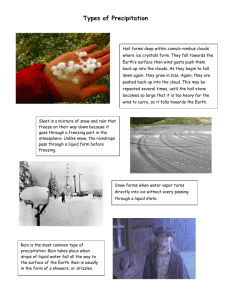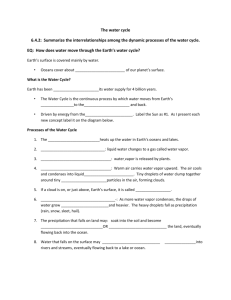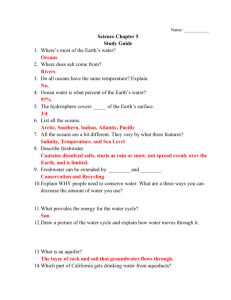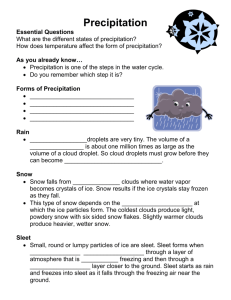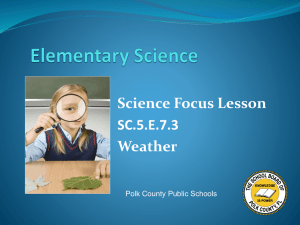Processes of the Water Cycle and Precipitation - JGMS
advertisement
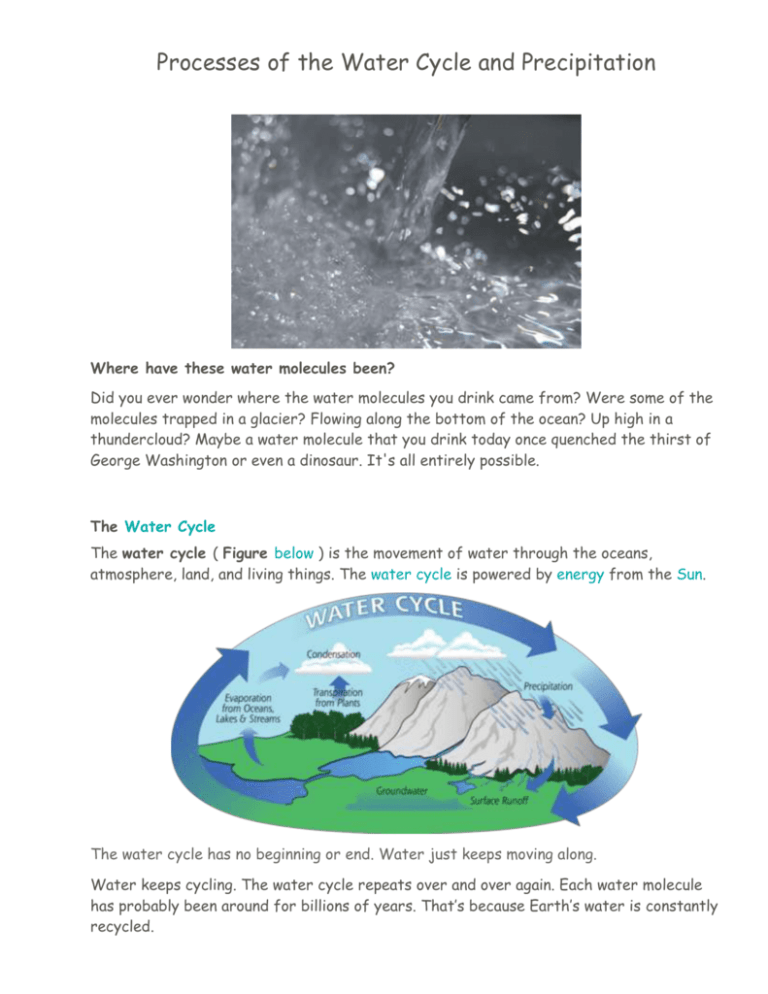
Processes of the Water Cycle and Precipitation Where have these water molecules been? Did you ever wonder where the water molecules you drink came from? Were some of the molecules trapped in a glacier? Flowing along the bottom of the ocean? Up high in a thundercloud? Maybe a water molecule that you drink today once quenched the thirst of George Washington or even a dinosaur. It's all entirely possible. The Water Cycle The water cycle ( Figure below ) is the movement of water through the oceans, atmosphere, land, and living things. The water cycle is powered by energy from the Sun. The water cycle has no beginning or end. Water just keeps moving along. Water keeps cycling. The water cycle repeats over and over again. Each water molecule has probably been around for billions of years. That’s because Earth’s water is constantly recycled. Processes in the Water Cycle Water keeps changing state as it goes through the water cycle. This means that it can be a solid, liquid, or gas. How does water change state? How does it keep moving through the cycle? As seen above ( Figure above ), several processes are involved. Evaporation changes liquid water to water vapor. Energy from the Sun causes water to evaporate. Most evaporation is from the oceans because they cover so much area. The water vapor rises into the atmosphere. This is important because water needs to enter the atmosphere in order to create clouds. Transpiration is like evaporation because it changes liquid water to water vapor. In transpiration, plants release water vapor through their leaves ( Figure below ). This water vapor rises into the atmosphere. Liquid water is taken up by plant roots. The plant releases water vapor into the atmosphere. This is transpiration. Condensation changes water vapor to liquid water. As air rises higher into the atmosphere, it cools. Cool air can hold less water vapor than warm air. So some of the water vapor condenses into water droplets. Water droplets may form clouds. Below is an example ofcondensation ( Figure below ). Without condensation, we would not have precipitation. A bottle that comes out of the refrigerator is cold. It cools the air near the bottle. Cooler air can hold less water so water vapor condenses onto the bottle. Precipitation is water that falls from clouds to Earth’s surface. Water droplets in clouds fall to Earth when they become too large to stay aloft. The water falls as rain if the air is warm. If the air is cold, the water may freeze and fall as snow, sleet, or hail. Most precipitation falls into the oceans. Some falls on land. Without precipitation, water would not be able to return to Earth’s surface. Runoff is precipitation that flows over the surface of the land. This water may travel to a river, lake, or ocean. Runoff may pick up fertilizer and other pollutants and deliver them to a water body. In this way, runoff may pollute bodies of water. Infiltration is the process by which water soaks into the ground. Some of the water may seep deep underground. Some may stay in the soil, where plants can absorb it with their roots. Do you live in a place that gets lots of rain? In some places it rains so much that people barely notice it. In others it rains so little that a rainy day is revered. Rain is not the only type of precipitation; see a few below. Precipitation Precipitation ( Figure below ) is an extremely important part of weather. Water vapor condenses and usually falls to create precipitation. The type of precipitation you receive depends on temperatures both in the clouds, in the air, and at the ground. Meterologists, scientists who study weather, measure liquid precipitation (rain/drizzle) using a rain gauge and report the total in inches. When the precipitation is frozen (snow/sleet), usually the total is measure with a ruler and is reported in inches. Dew and Frost Some precipitation forms in place. Dew forms when moist air cools below its dew point on a cold surface. Frost is dew that forms when the air temperature is below freezing. (a) Dew on a flower. (b) Frost. Precipitation From Clouds The most common precipitation comes from clouds. Rain or snow droplets grow as they ride air currents in a cloud and collect other droplets ( Figure below ). They fall when they become heavy enough to escape from the rising air currents that hold them up in the cloud. One million cloud droplets will combine to make only one rain drop! Rain falls in liquid form. If temperatures are cold, the droplet will hit the ground as snow. Snow is when water droplets freeze in the clouds and fall as frozen precipitation. (a) Rain falls from clouds when the temperature is fairly warm. (b) Snow storm in Helsinki, Finland. Other less common types of precipitation are sleet ( Figure below ). Sleet is rain that becomes ice as it hits a layer of freezing air near the ground. Sleet starts off as rain but freezes before hitting the ground. If a frigid raindrop freezes on the frigid ground, it forms freezing rain. Freezing rain remains liquid until it hits something frozen such as a car, power lines, or trees. Hail forms in cumulonimbus clouds with strong upward moving winds. The ice particle gets tossed over and over again in the clouds, picking up more layers of ice. An ice particle travels until it finally becomes too heavy and it drops. (a) Sleet. (b) Freezing Rain. (c) Hail. This large hail stone is about 6 cm (2.5 inches) in diameter.
